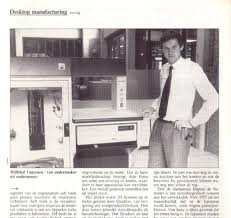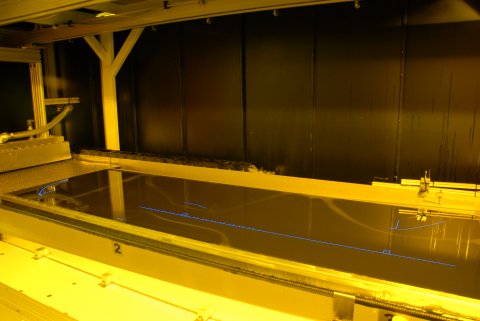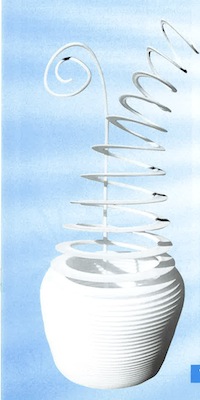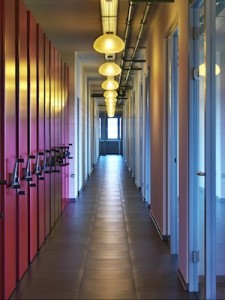Fried Vancraen is the founder and CEO of Materialise, the Belgian 3D Printing and Additive Manufacturing service, software and medical company. Fried is a tireless and true evangelist when it comes to 3D printing, which, together with his exceptional dignity, vast depth of knowledge, humble approach and unequivocal ethics makes him truly unique within the 3D printing sector. When he speaks, everyone should listen.
Rachel Park was privileged to interview Fried at Euromold 2012 recently as part of 3DPI’s ongoing Executive Interview Series and the results are published here in full.
3D Printing Industry: Can I just take you back to the very beginning? How was Materialise conceived and can you remember the first part you printed?
Fried Vancraen: I remember reading about the 3D printing (or just stereolithography as it was then) concept back in 1988, at the occasion of the first 3D printer presentation at Autofact. I kind of parked it in my brain somewhere but I didn’t really appreciate it. It wasn’t until the end of 1989 when I saw the first or second commercial machine, which was exported to Europe, at the BIBA research institute that I finally understood and appreciated the relevance of this technology for making things in a completely different way.
At the time I was working at the Belgian Research Institute of Metal Working with CNC technologies, which have a ridiculous amount of complexity built in to them, with controllers to control controllers and the like. The simplicity of the SLA-1 was stark — conceptually it was very different to anything that went before and I saw the immense potential of it then and for the future.

I do remember the first part I printed, it was a “wuerfel” – a simple cube shape with a tetrahedral inside it. I still have it at home. It was my ‘learning piece’.
3D Printing Industry: The evolution of Materialise is truly one of the greatest success stories of the 3D printing sector in my opinion — can you tell us about the diversification into software and the medical applications.
Fried Vancraen: Actually, we have eight business divisions now*. Originally the separate divisions were born out of necessity because we had to make the stereolithography (SL) process work for our customers and for the business. The existing software was not great, to say the least, it took us 1 month to prepare the data for our first client part (for Alcatel). This was 1990 don’t forget – we had to start with 2D drawings and design in 3D ourselves. We had CATS/Unigraphics with lousy .stl interfaces that were so very time consuming and a complete nightmare. We were essentially designing layer by layer. In the third week of Materialise’s existence, Johan Pauwels (then a job student and now a vice president) stayed up an entire night decoding the slice files and from there we started developing more workable software. We decided to sell the software to our competitors for a couple of reasons. First it would benefit the whole industry and second, if we sold it we could develop more, which again benefitted everyone, including us.
3D Printing Industry: At the last count, how many 3D printing systems do you have in house at Materialise?
Fried Vancraen: Worldwide we have a total of 84 additive manufacturing machines in operation. The majority (78) are based at our HQ in Leuven, Belgium, which is the largest European facility and services our customers as well as the .MGX and i.materialise business divisions. We also have 6 machines in the US. We use a range of processes to fulfill the many different applications that there are now with a full range of materials too.
3D Printing Industry: For me, one of the most jaw dropping moments in my personal 3DP history was seeing a Mammoth ‘3D printer’ in operation. Can you tell us about when, why and how Materialise developed this system and the competitive advantage it offers your clients.
Fried Vancraen: We never intended — or wanted — to develop machines. As I said, we decided early on that the software development and the service provision was vital to support the business and it turned out that the hardware needed similar attention. Don’t get me wrong, the system we bought was fantastic, but it was immature and needed R&D work. One of our earliest shareholders in Materialise was the University of Leuven and they were keen to get involved in this side of things. A young professor by the name of Kruth was particularly keen to work on this “non-conventional manufacturing” technique. Actually, as a point of interest, I believe it was Prof Kruth who first coined the phrase “additive manufacturing” in a paper he presented in 1991/92.

3D Printing Industry: In terms of the industries that you serve can you tell us where you have seen the biggest growth areas in the last ten years in terms of 3D printing prototyping and manufacturing applications.
Fried Vancraen: Absolutely – this is an easy question to answer. In the last five years the orthopaedic sector has seen huge growth. 5-10 years ago the biggest growth area was easily with dental applications. I am passionate about medical applications — my background is medical engineering so it is probably not that much of a surprise. But I totally believe, and always have, that technology should be used to make our world better. That is central to everything that we do at Materialise — right across the board.

3D Printing Industry: Can you explain the .MGX and i.materialise concepts, which are the consumer facing business models of Materialise. I think I am correct in saying that you were among the first organizations to realize the potential of 3D printing for the consumer – would you agree?
Fried Vancraen: Yes, actually I think that is right. I first knew that 3D printing technology was relevant for consumers in 1999 and we started to develop a strategy then to address the potential consumer market. We approached some independent designers to see if we could get them interested — and they were. I think it was Ron Arad who was the first designer to create a consumer product that was produced using 3D printing. It was a spiral lamp and it was sold to Karl Lagerfeld, if I remember correctly.
Two years ago we set up the .MGX retail store in Brussels because we could not accommodate it within our industrial space, although we have extended dramatically since then and we have now created a much bigger show room in our building to showcase our .MGX products as well as designs created through i.materialise. In fact, we have decorated our newest building entirely with .MGX products. The building itself is quite minimalist and basic and this allows the lamps to work their magic and help transform our hallways, offices, meeting rooms and cafeteria. It is always well received.

I will fight it wherever I can.
Also, some of the press distort the reality of what this technology can do and who can do it. As an example there was an article in a Belgian media outlet recently that said that soldiers injured in the line of duty could be fixed immediately — on the spot — with 3D printed medical applications, among other hype. Together with a group of surgeons who use this technology, I called a press conference to dispel this myth and challenge the hype. Often the sorts of injuries that they were reporting can be largely overcome with the help of 3D printed solutions, however they take months of preparation and planning after the patient is finally stabilized, not to mention extensive expertise and this only aids the physical recovery of these people it does not touch the emotional and psychological suffering they have endured. It is just a small part and it is SO important to bring people to the right way of thinking about the technology.
3D Printing Industry: What is your take on the “3D print a gun” stories from earlier this year?
Fried Vancraen: It is quite simple: from the very beginning, Materialise is about working to make the world a better place. Right back at the start, my wife and I decided that we would never work for the development or production of weapons.
3D Printing Industry: In terms of 3D printing applications, do you have a favourite and will you share it with us?
Fried Vancraen: That’s a difficult one – there are so many. But I would probably have to say the personalized medical implants that improve people’s lives for the better. The design takes into account the complex structure of their bodies, including muscles and bones and it makes such a positive difference. Being able to do this is the culmination of 20+ years work and it makes me happy to continue to do it.
3D Printing Industry: What is your vision for the next five years for 3D printing and for Materialise?
Fried Vancraen: From a technical point of view, I think we will continue to see a similar growth rate as we have in the last 5 years with ongoing success stories and a serious growth rate that will see great evolution of the sector.
For Materialise too, I think our evolution will also continue. My ambition is that within 10 years the company will be involved with touching 1 billion people (directly and indirectly) with 3D printing and helping to make a better world.
[nggallery id=30]* The Business Units of Materialise:
- Additive Manufacturing Solutions: A service bureau dedicated to the manufacturing of prototypes and AM end products
- Software for Additive Manufacturing: A software development team crazy about creating software and solutions for Additive Manufacturing, design automation and process management.
- RapidFit+: A band of car enthusiasts who work hard to provide customized jigs, fixtures and quality control solutions.
- Biomedical Engineering: A clever collection of engineers and developers who develop software and solutions for biomedical R&D.
- Orthopaedics: A dedicated and very healthy group of individuals who provide solutions for orthopaedic surgeons.
- Cranio-maxillofacial: A smiling crew of specialists who provide solutions for cranio-maxillofacial surgeons and clinicians.
- i.materialise: A fun-loving and energetic group of people who give consumers access to Additive Manufacturing and 3D Printing through their online service.
- .MGX by Materialise: The most stylish team in the company, they design products using AM in collaboration with renowned designers worldwide.



